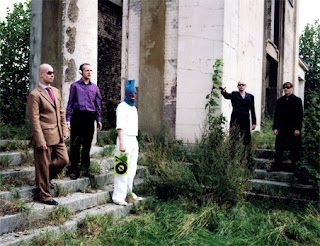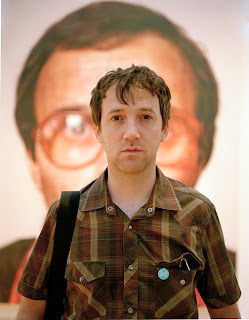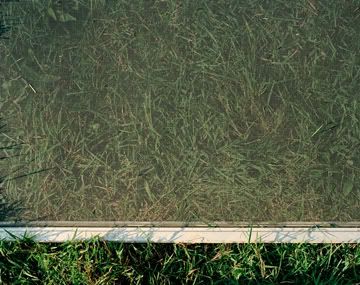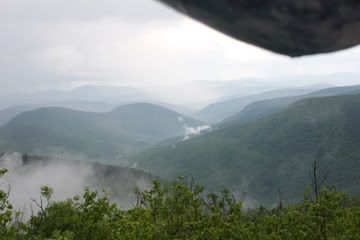http://www.sarahwilmer.com Email: sarahwilmer@gmail.com
http://www.shanebrennan.net Email: shane.m.brennan@gmail.com
Sunday, October 28, 2007
Saturday, October 27, 2007
Brendan Fernandes
check him out: http://www.brendanfernandes.ca/
email him: brendan@brendanfernandes.ca
email him: brendan@brendanfernandes.ca
Thursday, October 25, 2007
ReConstructions (a begining)
:
( Farway places seem the closest as remote ideas the ones I hold in my heart. I have been left, lost, cheated & lied to but I have never, ever been betrayed by my own fantasies. In fact some of them have even become ardent realities. )
What do memories mean to a nation that has none ? History is constructed with when the bullet’s outside the barrel & shutter is snapped shut. We edit our definitions with every image pasted in the album or placed in textbooks. The real is demonstrated in facts, the lens is a science & the camera a sword.
( The pictures of me on the first day of school lasted a year into the first grade, for father was taken before graduation & mother opted not to draw the camera. Mine is a childhood forgotten & seldom recorded. I remember naught before this moment. )
Our task is not to make you believe what we believe so much as to make you see exactly what we see. We fight for the right to be represented as to be seen & heard is as to breath. Yet the soldier in Capa’s picture, did he actually fall ? Facts have become unstable & all constructions de . . .
( I want to build myself a new life but I’m afraid to find the words their meanings. )
So we shant speak for truth anymore, & we could never speak for you. Ours is a new state of desire & a government of infinite questioning. Our propaganda will not deliver to you the word as our sentences are made up of yrs & yrs & yrs. We had a dream tomorrow night of the great fires of yesterday.
( This vision is the real of imagination, rumination & literature. I speak of when only when told. For then does not exist only this moment in now. )
We want to talk to you. To hear yr words & breath yr thoughts. We are not here to tell you anymore. We seek only to listen & re record the images & bullets yr own eyes have seen. For histories do not repeat themselves so much as undulate & intertwine. A new text is forming from deep within the mines.
( The time is now. The place is here. The I is We. )
:
( Farway places seem the closest as remote ideas the ones I hold in my heart. I have been left, lost, cheated & lied to but I have never, ever been betrayed by my own fantasies. In fact some of them have even become ardent realities. )
What do memories mean to a nation that has none ? History is constructed with when the bullet’s outside the barrel & shutter is snapped shut. We edit our definitions with every image pasted in the album or placed in textbooks. The real is demonstrated in facts, the lens is a science & the camera a sword.
( The pictures of me on the first day of school lasted a year into the first grade, for father was taken before graduation & mother opted not to draw the camera. Mine is a childhood forgotten & seldom recorded. I remember naught before this moment. )
Our task is not to make you believe what we believe so much as to make you see exactly what we see. We fight for the right to be represented as to be seen & heard is as to breath. Yet the soldier in Capa’s picture, did he actually fall ? Facts have become unstable & all constructions de . . .
( I want to build myself a new life but I’m afraid to find the words their meanings. )
So we shant speak for truth anymore, & we could never speak for you. Ours is a new state of desire & a government of infinite questioning. Our propaganda will not deliver to you the word as our sentences are made up of yrs & yrs & yrs. We had a dream tomorrow night of the great fires of yesterday.
( This vision is the real of imagination, rumination & literature. I speak of when only when told. For then does not exist only this moment in now. )
We want to talk to you. To hear yr words & breath yr thoughts. We are not here to tell you anymore. We seek only to listen & re record the images & bullets yr own eyes have seen. For histories do not repeat themselves so much as undulate & intertwine. A new text is forming from deep within the mines.
( The time is now. The place is here. The I is We. )
:
Wednesday, October 24, 2007
map of me
Sunday, October 21, 2007
Adorno's Aesthetic Theory
I have been working on condensing Theodor Adorno's Aesthetic Theory. Via this link, find half of the book condensed, complete with headings, bullet points, and abbreviations. Movie version is on the way. Since I had initially been interested in everyone reading this book but then realized that there was not going to be enough time to do so, I thought this would be the next best thing.
Friday, October 19, 2007
Wednesday, October 17, 2007
Readings for October 27th
“The Mobilized and Virtual Gaze in Modernity,” by Anne Friedberg – The Visual Culture Reader - Click Here
“Spectres of Cyberspace,” by Geoffrey Batchen – The Visual Culture Reader - Click Here
“Spectres of Cyberspace,” by Geoffrey Batchen – The Visual Culture Reader - Click Here
Saturday, October 13, 2007
The Fine Line Between Self Constructions
"Understanding, Participating in and Portraying the City"



While Baudelaire characterized the flâneur as a "gentleman stroller of city streets", he saw the flâneur as having a key role in understanding, participating in and portraying the city. A flâneur thus played a double role in city life and in theory, that is, while remaining a detached observer. This stance, simultaneously part of and apart from, combines sociological, anthropological, literary and historical notions of the relationship between the individual and the greater populace. After the 1848 Revolution, after which the empire was reestablished with clearly bourgeois pretensions of "order" and "morals", Baudelaire began asserting that traditional art was inadequate for the new dynamic complications of modern life.
Friday, October 12, 2007
I've heard this is the place!



But for the present age, which prefers the sign to the thing signified, the copy to the original, representation to reality, appearance to essence… truth is considered profane, and only illusion is sacred. Sacredness is in fact held to be enhanced in proportion as truth decreases and illusion increases, so that the highest degree of illusion comes to be the highest degree of sacredness. –Feuerbach 1841
Collapsed, unfolded, contained...constructed
from lauren...
here are some images i did this summer:



the first is one i made while at burning man in nevada. it's called mom's blue dress. it's a dress she made in the 70's (which is when i was born). it's sort of a meditation on her youth and mine.
the second i also made while at burning man. it was for bobby, who was very ill at the time and passed away two weeks ago. while at burning man, i had a chance to reflect on how my life, at that present moment, had become an intense mix of celebration and suffering. bobby loved this picture.
the third is from a series of pictures i made while visiting a corn maze...also a metaphor for the large uncertainties i was facing over the last several months. i don't really know what it means but i like it.



the first is one i made while at burning man in nevada. it's called mom's blue dress. it's a dress she made in the 70's (which is when i was born). it's sort of a meditation on her youth and mine.
the second i also made while at burning man. it was for bobby, who was very ill at the time and passed away two weeks ago. while at burning man, i had a chance to reflect on how my life, at that present moment, had become an intense mix of celebration and suffering. bobby loved this picture.
the third is from a series of pictures i made while visiting a corn maze...also a metaphor for the large uncertainties i was facing over the last several months. i don't really know what it means but i like it.
now for some constructivity . . .
here are three photographs i made this summer :



& here is verbal construction written in 1983 by poet Robert Kelly :
Doors
Suppose you didnt know what a door is. That it opens, for instance.
It would seem a different part of the wall, thinner, more resonant.
A decorative rectangle set in the wall, an embodiment of some
geometrical mystery like the Golden Section. It would seem tantaliz-
ing to someone trapped in the room -- a perverse, mean tease: the wall
is thin here, soft, but still unpassable. How little it would take to
get through the wall, yet you cant.
Suppose you didnt know what a door is, that it can open, that its
resistance defines the zone of least resistance, but that zone requires
a deft use of something learned, a knack, a skill: twisting the knob
and pulling. Or pushing. Even if you got as far as turning and pulling,
if the door were the kind that opened outward, you'd still never guess,
never get through.
Suppose all round us there are things like doors in things like walls
and we never knew.
: reb



& here is verbal construction written in 1983 by poet Robert Kelly :
Doors
Suppose you didnt know what a door is. That it opens, for instance.
It would seem a different part of the wall, thinner, more resonant.
A decorative rectangle set in the wall, an embodiment of some
geometrical mystery like the Golden Section. It would seem tantaliz-
ing to someone trapped in the room -- a perverse, mean tease: the wall
is thin here, soft, but still unpassable. How little it would take to
get through the wall, yet you cant.
Suppose you didnt know what a door is, that it can open, that its
resistance defines the zone of least resistance, but that zone requires
a deft use of something learned, a knack, a skill: twisting the knob
and pulling. Or pushing. Even if you got as far as turning and pulling,
if the door were the kind that opened outward, you'd still never guess,
never get through.
Suppose all round us there are things like doors in things like walls
and we never knew.
: reb
Thursday, October 11, 2007
Jane's Lament
Saturday, October 6, 2007
Tuesday, October 2, 2007
Readings for October 13th
The Decisive Moment - Henri Cartier-Bresson
On Collecting Art and Culture - James Clifford
In Richard Handler's discussion on an individual or a group having culture, he brings up the point that collections/presentations of an "authentic domain of identity" can't be natural or innocent as they are tied up with "nationalist politics, restrictive law and contested encodings of past and future". Clifford points out that the different types of collecting fulfill different purposes. Largely, in the West, strategies to deploy a possessive self culture and authenticity, a societal need to own to become your own person and navigate through a world-understanding, or in cultures that aren't controlled by capitalism (Baudrillard), collecting to redistribute a kind of open source sharing and building upon a collective culture. In Susan Stewart's studies of miniaturization versus gigantism and the souvenir versus the collection all create the illusion of an adequate representation of a world and explores how time-lines prevail over museum display eliminating the original social context. Clifford asks a very important question: Why has it seemed obvious until recently that non-Western objects should be preserved in European museums, even when this means that no fine specimens are visible in their country of origin? He also makes a fascinating semiotic square diagram illustrating the collection categories and their mutability. Later, he makes the point that the museum is itself a museum, and modernizing museums is defeating one layer of history - the history of that moment in collecting.
Visual Stories - Ann Reynolds
The discussion of the layout of space in the AMNH and why is a fascinating one. Reasons range, from the search for new funding to the invention of a modern story and a necessary adjustment because of how the modern visitor learns are acute perceptions to create the necessary "true illusion" but on the other hand these techniques train us to read visually in a formatted way. The dioramas themselves are distorted enough to make the viewer understand that this is a construction, a "landscape". Then, it is fascinatingly related to world peace by Albert Parr (not Alfred Parr as Ann Reynolds writes) who writes, "a total conception of the whole of nature as a balanced system," as a model for social cooperation which, when understood and 'cultivated' locally, could create a model for world peace.
On Collecting Art and Culture - James Clifford
In Richard Handler's discussion on an individual or a group having culture, he brings up the point that collections/presentations of an "authentic domain of identity" can't be natural or innocent as they are tied up with "nationalist politics, restrictive law and contested encodings of past and future". Clifford points out that the different types of collecting fulfill different purposes. Largely, in the West, strategies to deploy a possessive self culture and authenticity, a societal need to own to become your own person and navigate through a world-understanding, or in cultures that aren't controlled by capitalism (Baudrillard), collecting to redistribute a kind of open source sharing and building upon a collective culture. In Susan Stewart's studies of miniaturization versus gigantism and the souvenir versus the collection all create the illusion of an adequate representation of a world and explores how time-lines prevail over museum display eliminating the original social context. Clifford asks a very important question: Why has it seemed obvious until recently that non-Western objects should be preserved in European museums, even when this means that no fine specimens are visible in their country of origin? He also makes a fascinating semiotic square diagram illustrating the collection categories and their mutability. Later, he makes the point that the museum is itself a museum, and modernizing museums is defeating one layer of history - the history of that moment in collecting.
Visual Stories - Ann Reynolds
The discussion of the layout of space in the AMNH and why is a fascinating one. Reasons range, from the search for new funding to the invention of a modern story and a necessary adjustment because of how the modern visitor learns are acute perceptions to create the necessary "true illusion" but on the other hand these techniques train us to read visually in a formatted way. The dioramas themselves are distorted enough to make the viewer understand that this is a construction, a "landscape". Then, it is fascinatingly related to world peace by Albert Parr (not Alfred Parr as Ann Reynolds writes) who writes, "a total conception of the whole of nature as a balanced system," as a model for social cooperation which, when understood and 'cultivated' locally, could create a model for world peace.
Monday, October 1, 2007
The Course
The Constructed Moment
Texts:
Visual Culture Reader, Ed. Nicholas Mirzoeff
Aesthetic Theory, Theodor Adorno
Class 1 - Saturday, September 29, 2007
Everyone introduces his/her work I(10-15 min. presentations)
Discussion and slideshow: construction as a topic and ideal in art and photography.
Assignments for Class 2:
Introduction to http://constructedmoment.blogspot.com
I will email everybody invitations to sign up. Sign up to be a participant. Suggested ways to participate: Post three of your works. Post a piece of writing relevant to a facet of your artwork (by someone else) or an artist’s work that has influenced you. (Commenting on the works posted by others is encouraged.)
Exercise in Mapping: Map yourself as an artist. Do this in any form that you want. Think about external nonacademic formats: obviously photography seems relevant here, also websites, sculptures, and word-webs are examples of how to structure this map. Think about doing it in a way that directly reflects you (or who you want to be), what you do, or what you like. This is a way to visualize the evolution of your work. This exercise can also be used as a way to BRAND YOURSELF. Present these in the next class.
Readings: “The Decisive Moment,” by Henri Cartier-Bresson.
“Visual Stories,” by Anne Reynolds - The Visual Culture Reader
“On Collecting Art and Culture,” by James Clifford -The Visual Culture Reader
All texts will be posted to the blog. Feel free to post comments.
Class 2 – Saturday, October 13, 2007
Part 1 (2:00 – 3:20PM):
Discuss mapping exercise and readings.
Part 2 (3:35 – 5:00PM):
View the video work of Larissa Sansour and The G77. (Subject to change)
Open discussion with Larissa Sansour, The G77, and Juan Puntes on the topic of construction within artistic interventions and art that deals with the political.
Assignments for Class 3:
Map out your idea for your final project.
Readings: “The Mobilized and Virtual Gaze in Modernity,” by Anne Friedberg – The Visual Culture Reader
“Spectres of Cyberspace,” by Geoffrey Batchen – The Visual Culture Reader
Class 3 – Saturday, October 27. 2007
Part 1 (2:00 – 3:20PM):
We will discuss the final projects and the stages of classmembers’ progress. Participants will present their work in progress.
Part 2 (3:35 – 5:00PM):
Talk about space and architecture, construction and branding with Lance Boge, Shane Brenan and Sarah Wilmer. (Subject to change)
Open discussion on the topics of Construction, Installation, and Space in Art with Lance Boge.
Class 4 – Saturday, November 10, 2007
View and critique final projects
End of Semester Assignment:
Create an immersive space for your work to be shown. Whatever work that you decide to create for this course, be it performance, video, photography installation, intervention, web-based work, or other, the space is extremely important to the perception and viewing of the work. Take chances. In the final class, we will visit and critique each artist’s created space. Consider the architecture, its transformative elements and history, whether the space is public or private, whether it is created by you, whether it is virtual or other architectural attributes. We will discuss recording these projects for the web.
Biographies of outside participants:
Class 2:
Larissa Sansour was born in Jerusalem in 1973, of a Russian mother and a Palestinian father. She lived in Beit Jala for 15 years before the events of the first Intifada forced her to continue her studies in London, England. She attended two art colleges in London and went on to complete her BFA at the Maryland Institute College of Art in America. In 2000, she received an MA in Art from New York University.
Her art (mainly video art) is greatly influenced by the Palestinian situation. In her work, she aims “to set the viewer off balance, breaking stereotypes of ethnicity as well as clichés in the framework of art display”. Her 2007 exhibitions include “In Focus,” Tate Modern, London; “The Dairy,” Center for the Arts, Boulder, CO; “://selfprortrait” a - show for Bethlehem; Macro - Museo de Arte Contemporáneo de Rosario, Rosario; “Paranoia,” Freud Museum, London.
Juan Puntes is the director of White Box, a non-profit organization located in the heart of the Chelsea art district in New York. White Box's mission is to show diverse contemporary art in the context of socially relevant issues and to present images and ideas that matter to large audiences. By linking contemporary art with current aesthetic and ethical issues, White Box is also able to provide innovative educational programs for students and adults, including seminars, lectures, readings, performances, and film and video screenings. By presenting truly critical art, White Box acts counter to the surrounding highly commercial environment and seeks to advance creative difference.
The G-77 began in 2003 when a group of visual artists (and contributors including geographers, biologists, writers, musicians, architects, and critical thinkers) convened In New York City to discuss current trends in cultural expression. As a result, this primarily anonymous group chose Aboveground Representatives to be their public voice. The G-77 is committed to seeking out alternative ways of gaining, absorbing, and disseminating concrete and poetic information and to act as a model for society at large.
Class 3:
Lance Boge. As design director for Gensler's retail studio in New York, Lance Boge creates branded environments, specializing in retail and prototype design for leading international retailers, financial companies, and banking organizations. Boge joined Gensler in 2000 with 16 years of previous professional experience. Throughout his career, Boge has worked with creative leaders in fields such as fashion, art, and advertising, creating spatial solutions appropriate to their varied demands. Boge has been a design critic at Yale University, Parsons School of Design, Harvard University, and Columbia University; he has taught at both Yale and Parsons. He earned a bachelor of arts from Boston University and a masters in architecture from Yale University.
Shane Brennan. Shane received a Bachelor of Arts degree in art, critical theory, and media studies from Brown University in 2007. He has worked and interned at a variety of art organizations, including Creative Time and the Whitney Museum of American Art. Shane is currently living in New York City, where he continues to pursue art, writing, and curating.
Sarah Wilmer. I am an image-maker and a storyteller. My process is intuitive and my pictures come from a very personal place. Space, time, mood, isolation and fantasy are common threads in my work. Together they tell narratives of quiet and mystery unified by shadow.
Subscribe to:
Posts (Atom)







